
Russian leader Vladimir Putin declared on Feb. 27 he was putting his nuclear forces into “special combat readiness” amid the global outcry over Russia’s invasion of Ukraine. The move was evocative of the worst moments during the Cold War. (These are the 14 former Soviet republics that joined NATO after the Cold War.)
Putin’s move to rattle his nuclear sword is a reminder that at least nine nations possess the most dangerous weapons ever developed, enough power to raze entire regions of the world and destroy nations.
Though the Cold War ended in 1989, several countries continue to develop nuclear arms capabilities. Russia is completing a decades-long effort to modernize its nuclear weapons systems, while the United States deployed 8-kiloton nuclear submarine-launched ballistic missiles as recently as 2019, according to the Bulletin of Atomic Scientists. China, India, and Pakistan are expanding their nuclear weapons capabilities, and Iran may be secretly developing its own nuclear weapons program. (These are the countries with the largest militaries.)
To determine the status of the world’s nuclear powers, 24/7 Wall St. reviewed warhead inventories for each country using estimates from the Federation of American Scientists, an organization that works to reduce the spread of nuclear weapons and increase government transparency. All other data comes from The Stockholm International Peace Research Institute.
Nuclear weapons vary in potency, ranging from small tactical nuclear devices to intercontinental ballistic missiles that can yield up to 800 kilotons, or about 44 times the power of the two nuclear bombs dropped on Hiroshima and Nagasaki in 1945. The smallest nuclear weapon system ever built was the American M28 and M29 (aka the Davy Crocket), with a yield of about 0.02 kilotons, equivalent to 20 tons of TNT.
The United States and Russia continue to maintain the most nuclear weapons, far more than the other seven nuclear powers combined. Fortunately, the number of nuclear weapons has declined significantly from its peak years prior to the end of the Cold War thanks in part to the Strategic Arms Reduction Treaty and the New START, which extended the treaty to 2026, between the U.S. and Russia. But plenty of nuclear firepower remains.
Here is the status of the world’s nine nuclear arsenals
Click here to read our detailed methodology
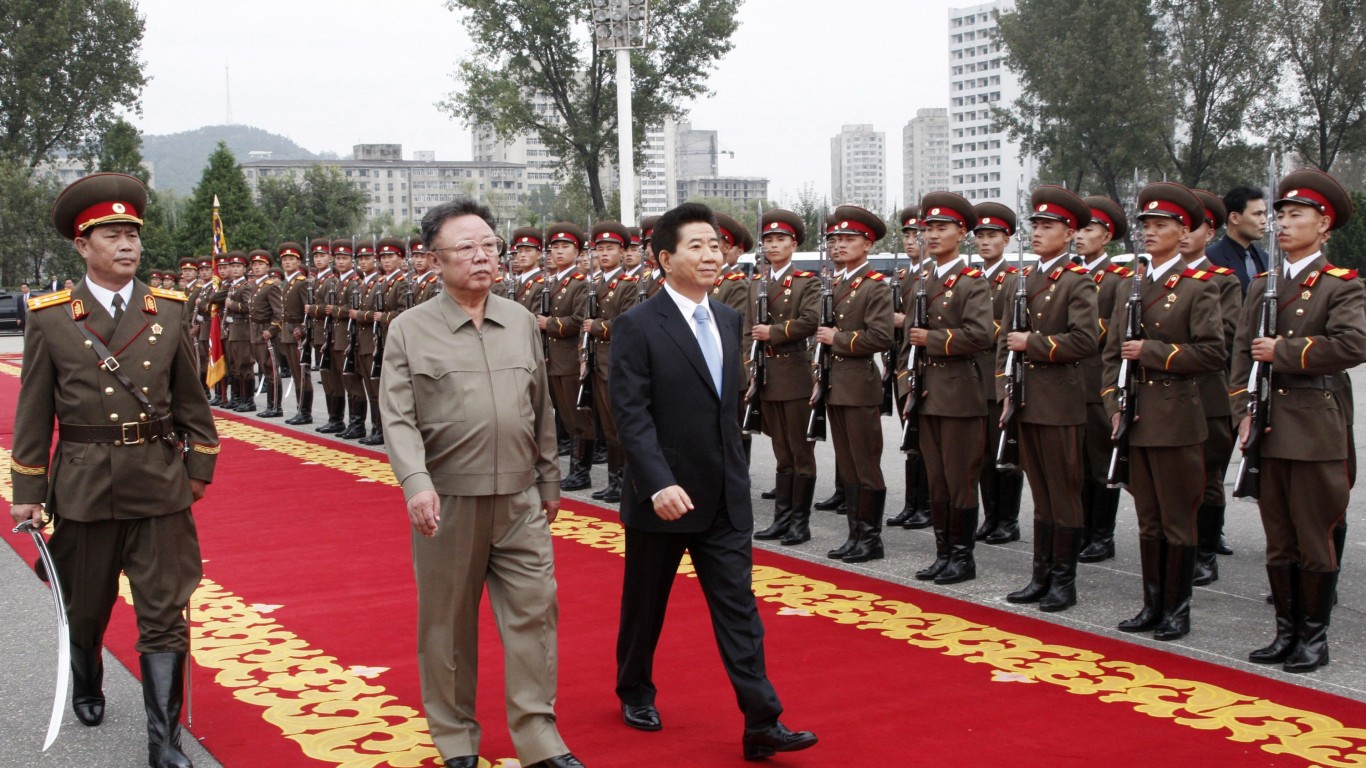
9. North Korea
> Total nuclear warheads: 20
> Number of deployed nuclear warheads: N/A
> Number of stored warheads: N/A
> Year of first test: 2006
> Defense budget (2020): N/A
Ever fearful of foreign intervention, leaders of the Hermit Kingdom have aggressively pursued the development of nuclear weapons systems to serve as a deterrent. North Korea maintains a “no-first-use” policy since its fourth nuclear weapons test in 2016, but the country’s strictly controlled media has made nuclear threats for perceived provocations, like U.S.-South Korean military exercises. FAS estimates that North Korea may have produced enough fissile material to build between 40 and 50 nuclear weapons, though it may not have assembled that many.
[in-text-ad]
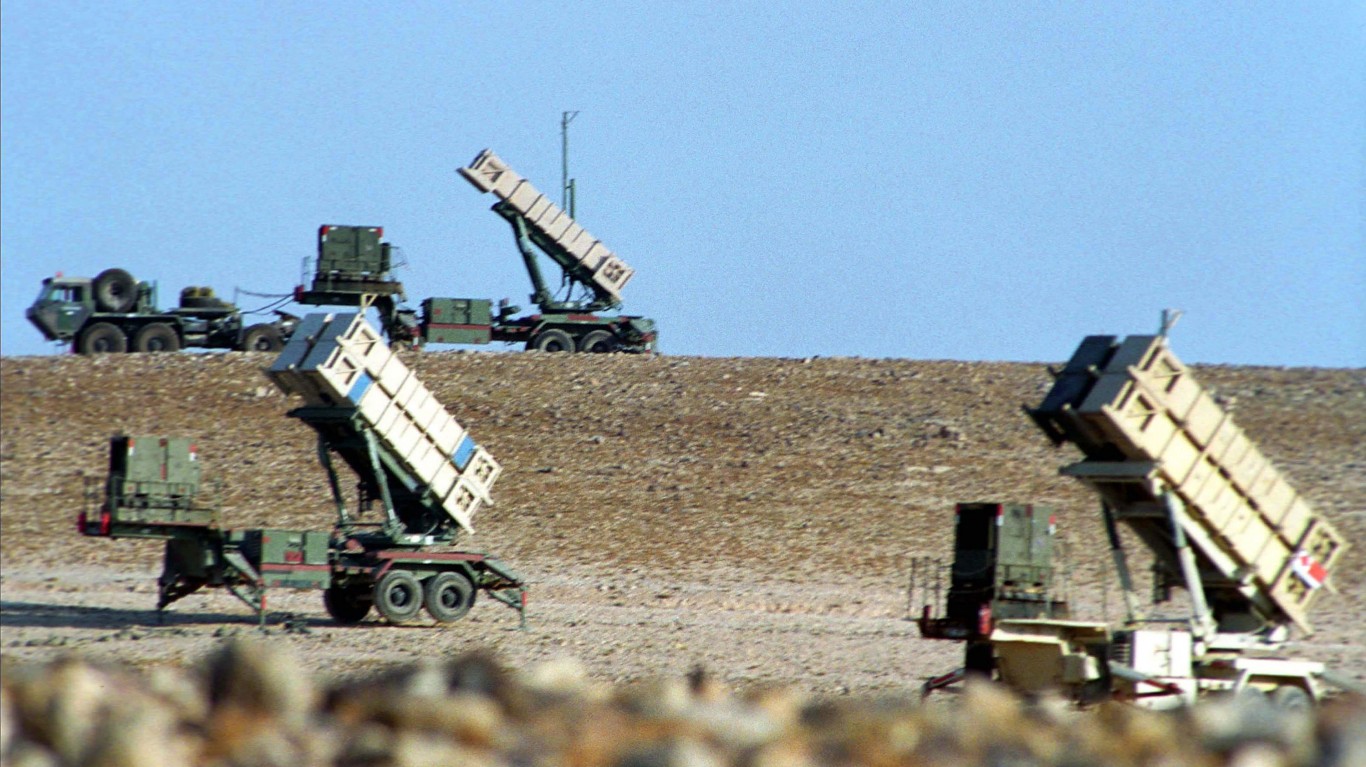
8. Israel
> Total nuclear warheads: 90
> Number of deployed nuclear warheads: N/A
> Number of stored warheads: 90
> Year of first test: 2008
> Defense budget (2020): $21.7 billion
It is an open secret that Israel has nuclear weapons, but because the country does not acknowledge its possession of such weapons, it is very difficult to conduct research on Israel’s nuclear capabilities. Still, it is believed that Israel has air and land-based nuclear weapons delivery systems as well as a rumored sea-based land-attack cruise missiles. Israel’s primary security concern is that Iran could soon develop its own nuclear weapons.

7. India
> Total nuclear warheads: 160
> Number of deployed nuclear warheads: N/A
> Number of stored warheads: 160
> Year of first test: 1974
> Defense budget (2020): $72.9 billion
India and Pakistan have stockpiled plenty of nuclear arms to wipe each other out amid cold war-like tensions regarding the territorial dispute of the Kashmir region that both countries claim. India can launch nuclear weapons by air, land, and sea, and it is believed to be expanding its land-based ballistic missile stockpile. India is estimated to have produced enough military plutonium for 150 to 200 nuclear warheads but has likely produced only 150 to 160.

6. Pakistan
> Total nuclear warheads: 165
> Number of deployed nuclear warheads: N/A
> Number of stored warheads: 165
> Year of first test: 1998
> Defense budget (2020): $10.4 billion
Tensions between Pakistan and India make this one of the world’s most tense nuclear standoffs. Both countries are expanding their nuclear arsenals and delivery systems. U.S. intelligence may vastly underestimate how many nuclear weapons Pakistan would have developed by 2020. Like its adversary, India, Pakistan can launch nuclear warheads from air, land, and sea. FAS estimates that the country’s stockpile could grow to around 200 by 2025.
[in-text-ad-2]

5. United Kingdom
> Total nuclear warheads: 225
> Number of deployed nuclear warheads: 120
> Number of stored warheads: 60
> Year of first test: 1952
> Defense budget (2020): $59.2 billion
The U.K. has the fifth-largest arsenal of nuclear weapons, with more than half available for quick deployment on four Vanguard-class nuclear-powered ballistic missile submarines. The U.K. is the only nuclear weapon country that has only one deterrence system. One Vanguard carrying about 40 warheads is deployed at sea at all times as an ongoing deterrent. In 2021, the U.K. government announced the country would increase its stockpile ceiling to up to 260 warheads.
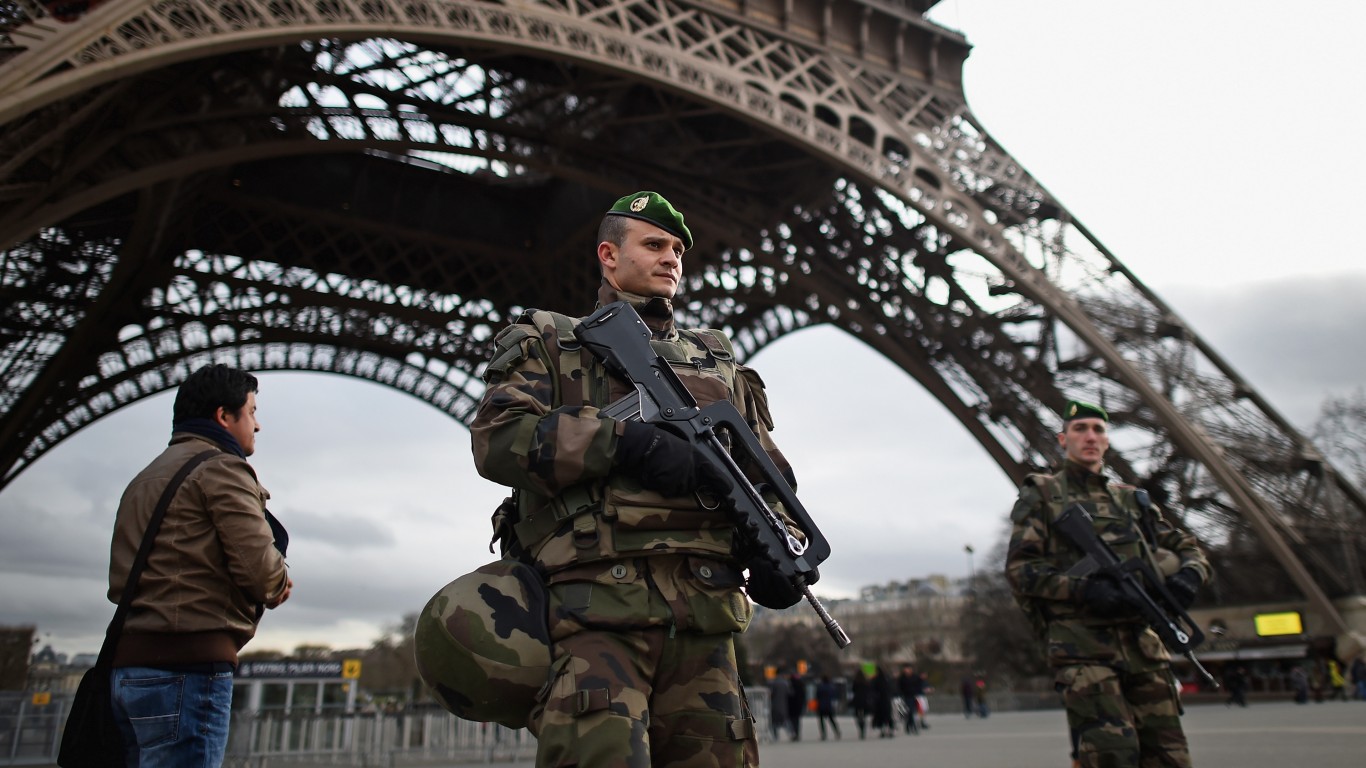
4. France
> Total nuclear warheads: 290
> Number of deployed nuclear warheads: 280
> Number of stored warheads: 10
> Year of first test: 1960
> Defense budget (2020): $52.7 billion
France has 65 more nuclear warheads than Britain, not counting about 10 warheads that are spares or in maintenance, making it the fourth-largest nuclear power. Unlike the United Kingdom, which maintains only a submarine-based force, France can launch 50 nuclear weapons from its Rafale fighter jets by land or aircraft carrier. The rest of its nuclear warheads are submarine based. France’s nuclear arsenal of nearly 300 warheads has remained stable in recent years, the FAS notes.
[in-text-ad]
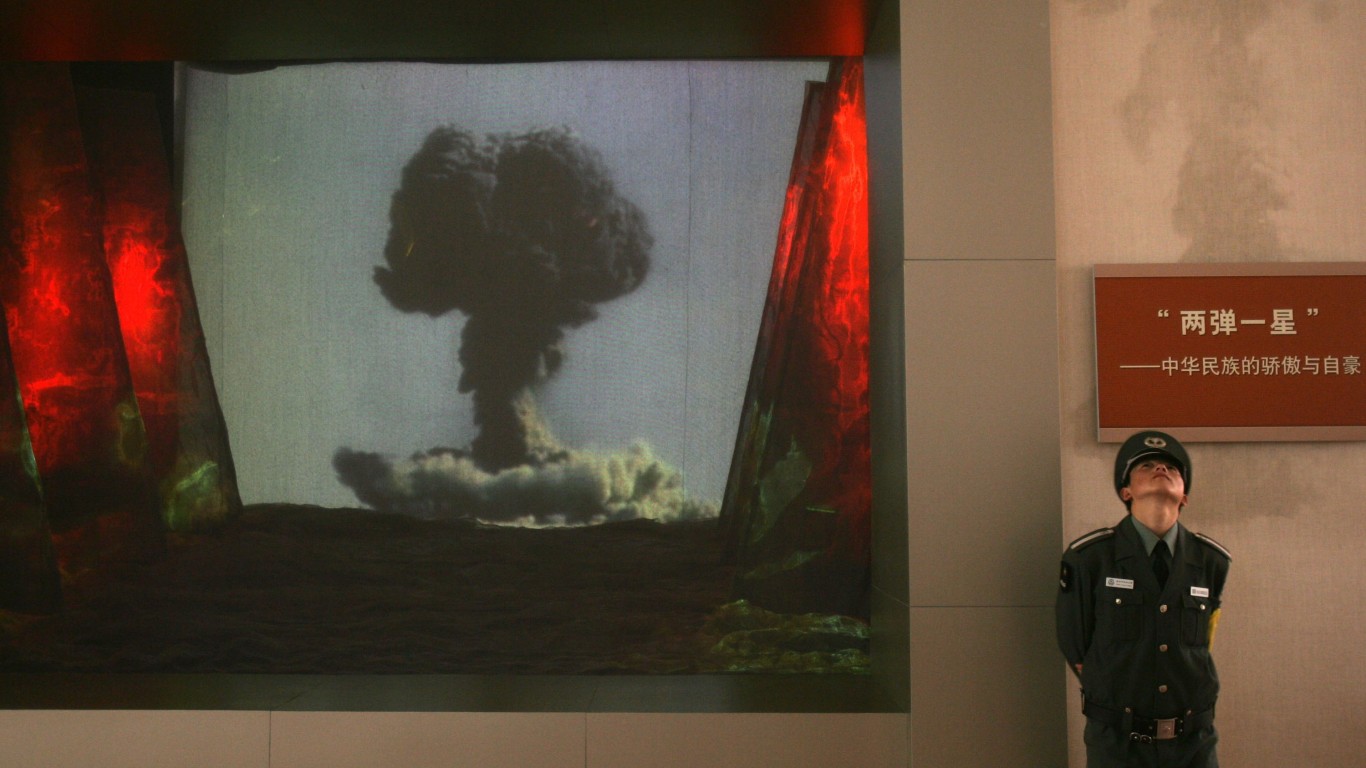
3. China
> Total nuclear warheads: 350
> Number of deployed nuclear warheads: N/A
> Number of stored warheads: 350
> Year of first test: 1964
> Defense budget (2020): $252.3 billion
China is believed to have the world’s third-largest nuclear arsenal, but its estimated 350 weapons systems is a fraction of the nearly 12,000 nuclear weapons held by the U.S. and Russia. But like Russia, China is modernizing its nuclear weapons systems to keep up with its competitors, including construction of new intercontinental missiles and missile silos. China’s stockpile is expected to increase significantly in the next decade, the FAS estimates.

2. United States
> Total nuclear warheads: 5,428
> Number of deployed nuclear warheads: 1,744
> Number of stored warheads: 1,964
> Year of first test: 1945
> Defense budget (2020): $778.2 billion
The United States is the oldest nuclear weapons country and the only one to have used nuclear bombs against another country. The oldest still active U.S. nuclear weapons stockpile was first deployed in 1961 and currently consist of 46 nuclear-capable B-52 bombers. The U.S. has deployed modern submarine-launched ballistic missiles since 2008. Of the near 1,800 deployed nuclear warheads, 400 are on land-based intercontinental ballistic missiles, roughly 1,000 are on submarine-launched ballistic missiles, 300 are at bomber bases in the U.S., and 100 tactical bombs are at European bases. The U.S. also retired 1,720 warheads.
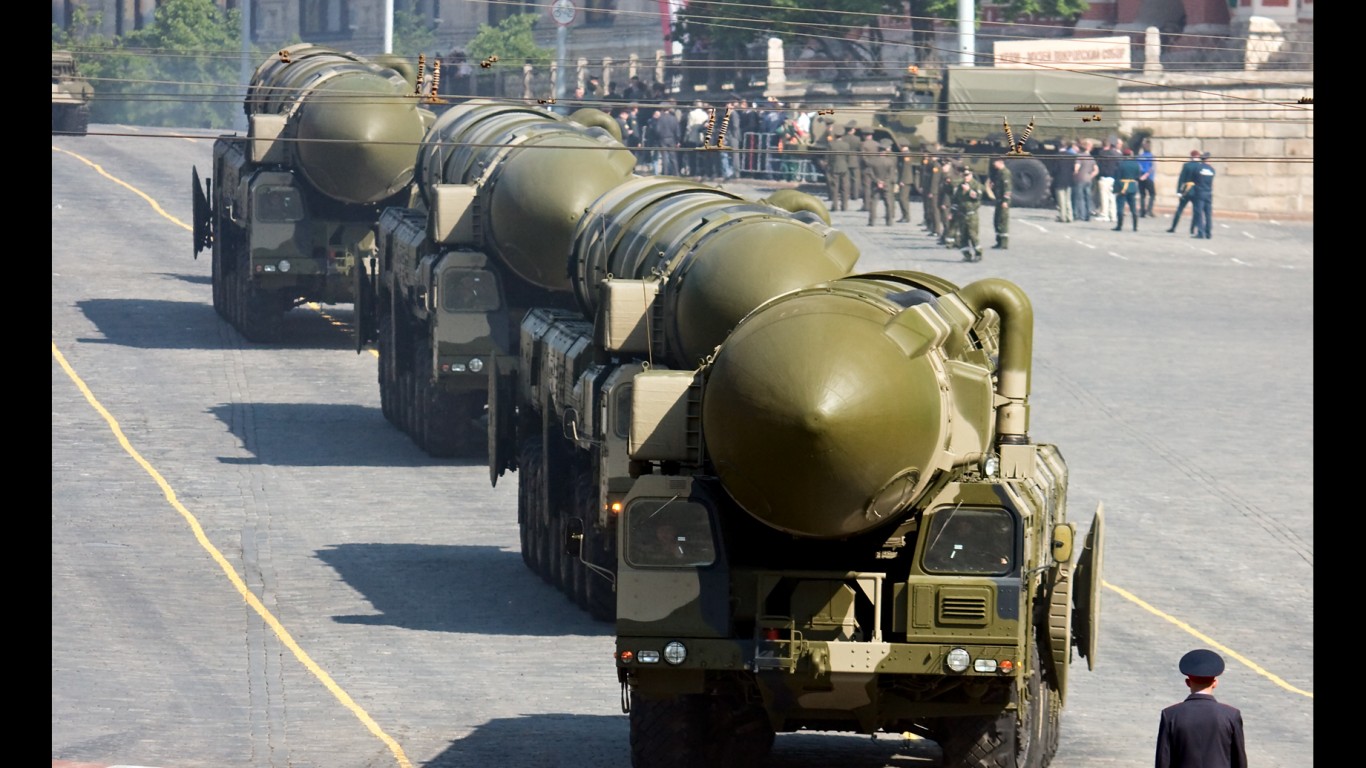
1. Russia
> Total nuclear warheads: 5,977
> Number of deployed nuclear warheads: 1,588
> Number of stored warheads: 2,889
> Year of first test: 1949
> Defense budget (2020): $61.7 billion
The Russian Federation is the largest nuclear power, with the largest arsenal of nuclear warheads. Russia is wrapping up a decades-long modernization of its nuclear arsenal, replacing Soviet-era weapons. Last year, Russia deployed additional nuclear cruise missiles that can be fired from its Tupolev Tu-160 (aka Blackjack) strategic bombers. Of Russia’s 4,477 deployed and stored warheads, about 1,588 strategic warheads are deployed on ballistic missiles and at heavy bomber bases. Russia also retired 1,500 warheads, the FAS estimates.
Methodology
To determine the status of the world’s nuclear powers, 24/7 Wall St. reviewed warhead inventories for each nuclear country as estimated by researchers at the Federation of American Scientists, an organization that works to reduce the spread of nuclear weapons and increase government transparency. FAS researchers used unclassified information to arrive at their estimates. In addition, researchers used a variety of sources, including satellite images, public statements from public officials, newspapers articles, private conversations with government officials, as well as historical analyses over many years were used to ascertain these estimates.
The year of each country’s first nuclear test, number of deployed warheads, stored warheads, and total inventory, as well as each nation’s military expenditure came from The Stockholm International Peace Research Institute.
100 Million Americans Are Missing This Crucial Retirement Tool
The thought of burdening your family with a financial disaster is most Americans’ nightmare. However, recent studies show that over 100 million Americans still don’t have proper life insurance in the event they pass away.
Life insurance can bring peace of mind – ensuring your loved ones are safeguarded against unforeseen expenses and debts. With premiums often lower than expected and a variety of plans tailored to different life stages and health conditions, securing a policy is more accessible than ever.
A quick, no-obligation quote can provide valuable insight into what’s available and what might best suit your family’s needs. Life insurance is a simple step you can take today to help secure peace of mind for your loved ones tomorrow.
Click here to learn how to get a quote in just a few minutes.
Thank you for reading! Have some feedback for us?
Contact the 24/7 Wall St. editorial team.
 24/7 Wall St.
24/7 Wall St.